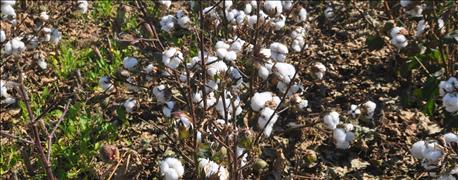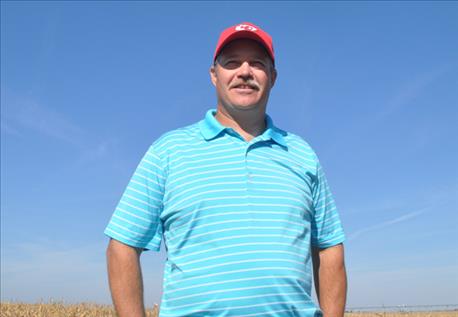
Planting cover crops by air into a cotton field showed less success than a similar effort on corn for a Barber County farmer.
Craig Mease knew that his friend and neighbor, Chris Boyd, was going to try an experiment to get his forage cover crop established faster and decided he wanted to try the technique on a field he had planted to cotton.
Both fields were aerial-seeded on the same day in early September.
Boyd checked the cotton field with seed dealer Jason Stucky in late October and found the stand of wheat and tillage radishes had not made as much progress in the cotton field as it had in Boyd's cornfield.

BIG DIFFERENCE: The open space between these cotton rows illustrates a stark difference in cover crop emergence after aerial seeding. On the left, there was enough leaf drop to allow sunlight between rows. On the right, the canopy was heavier and only a few cover crop plants are up and growing.
"I am thinking there was still too much canopy on the cotton crop," says Stucky. "In the spots where sunlight could hit the ground, the stand is much stronger."
Boyd says he is among a number of producers, seedsmen and others still learning the ins and outs of cover crops and how to best use them to benefit both the health of the soil and the bottom line of producers.
Boyd worked with National Resources Conservation Service technicians on his cornfield experiment with aerial-seeded cover crops. Erin Batman with the NRCS was able to get approval for a variance to NRCS standards and specifications for the aerial-seeding experiment.
"If we can determine that it is beneficial to seed cover crops from the air, then there is a possibility that we can adjust the cover crop standards and specifications to cover aerial as well as conventional seeding," he says.
He says a lot of decisions on when — and if — planting cover crops would be beneficial are still a trial and error process in much of Kansas, especially in the arid regions of western Kansas.

STILL LEARNING: Barber County farmer Chris Boyd says every field brings a new opportunity to learn more about the best practices for using cover crops.
"We do have some sound research that shows us that planting cover crops into wheat stubble can be very beneficial if there is sufficient moisture at the time the wheat is harvested to get a good stand of the cover crop," he says. "Research shows that a cover crop of sufficient stand to cover the ground keeps the soil cooler and results in less water loss in soil than in stubble alone. The growing cover crop also gives you the advantage of microbial activity in the soil that helps break down residue and reduces compaction."
That said, there can be conditions, especially in western Kansas, where there just isn't sufficient moisture to make growing a cover crop a wise decision.
"It is something that producers have to evaluate carefully and make the decision that is right for their operation," Batman says.
NRCS did not work with Mease on his cotton field experiment.
In the case of planting into the cotton field, Stucky says his advice would be to wait for more leaf drop before seeding.

TRIAL AND ERROR: There is still an element of learning by trial and error when it comes to how to get the most benefit from cover crops, says seed dealer Jason Stucky.
He says he also thinks that irrigation after seeding might be a critical step unless there is a rain within 24 to 36 hours of seeding.
"Since the seed is on top of the ground, you have to have moist soil to get it germinated and growing," he says.
Mease says he did not irrigate the cotton field, where Boyd did irrigate the cornfield after seeding.
Stucky says he thinks cover crops will play an important role going forward.
"Utilizing cover crops for forage can be a good way to help make something that helps the health of the soil also help producers make more money," he says.
About the Author(s)
You May Also Like




